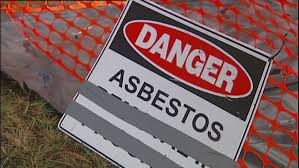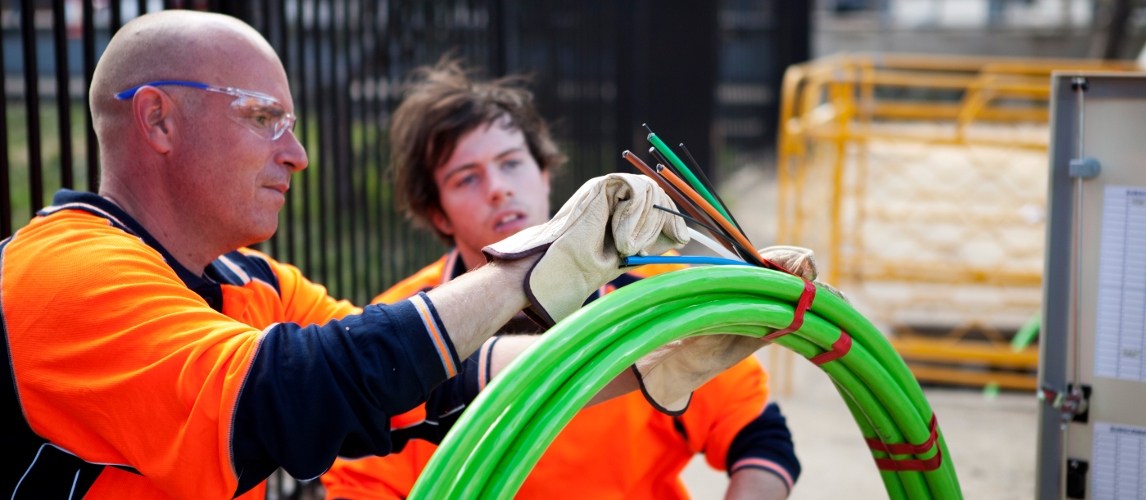
Telco e-Bulletin 2013 - #14
- Telstra posts 12.9% profit rise.
- Telstra: dispute over contractor training escalates.
- Telstra pit remediation programme to restart.
- Asbestos in Telstra: have you been exposed?
- Newcastle call centre: offshoring raises safety concerns.
- New Telstra travel allowance rates.
- Broadcast Australia agreement approved by employees.
- Service Stream exits NBN venture with major losses.
- Silcar signs last-minute contract extension
1. Telstra posts 12.9% profit rise
Telstra has posted strong full year financial results, recording a 12.9% rise in net profits despite modest 1.9% growth in overall revenues.
The results continued and underscored the basic trend which has been evident in the company for several years now – the centrality of mobile services to Telstra’s contemporary business and the related decline in its fixed wireline operations.

Other key growth areas were Network Applications and Services (NAS) and international, with NAS seeing strong revenue increases in cloud services (cloud (33%), unified communications (17.7%) and managed network services (20.7%).
International revenues rose 16.2% to A$1.74 billion, reflecting Telstra’s growing focus on regional opportunities.
Given these trends, it is not surprising to hear CEO David Thodey say that the company’s future lies in software – in software-based network services and “over the top” applications.
Here, as Thodey emphasised, Telstra continues to be well-served by its earlier investments in its core IP networks, just as it is in relation to its mobile infrastructure.
But those advantages won’t themselves ensure success. The CWU notes that Telstra’s overall results rely very much on cost “restraint” including cuts to labour costs (down 3.3% over the year). There is in the CWU’s view a danger that ongoing cuts in this area will close off near –to -mid -term business opportunities, such as fuller participation in NBN construction, and undermine customer service in both existing and emerging areas.
Reliance on outsourcing and off-shoring as a means of lowering labour costs also brings its own risks and creates its own inefficiencies, as the recent asbestos problem has demonstrated. The lessons of this episode need to be taken on board by those managing the transition which is now so clearly underway.
2. Telstra: dispute over contractor training escalates
The CWU is currently in dispute with Telstra over a programme involving ISGM trainees.
ISGM is a contracting company which now is the sole provider of sub-contractor labour working on the Telstra Customer Access Network (CAN).
Under a new scheme being introduced by Telstra/ISGM Telstra employees are being required to take potential ISGM trainees on ride-ons as part of a government-funded pre-apprenticeship programme. The programme is designed for unemployed and otherwise disadvantaged people who may be interested in working in the telecommunications industry.
If the candidates are suitable they will then be put through a traineeship designed to lead to a Certificate III (i.e. trade level) qualification.
Then – if they can find the start-up funds – they can become ISGM sub-contractors!
The CWU welcomes new entrants into the industry. But we have a number of problems with this scheme which appears to have been hastily put together to provide a quick fix for emerging skill shortages in the Telstra field workforce:
- Telstra employees are being asked to perform duties outside their job descriptions;
- Telstra has not clarified the question of OHS and related responsibilities/liabilities in relation to these trainees;
- Trainees (or would-be trainees) are reportedly going into the field without proper protective equipment.
- The traineeship itself appears to offer an extremely “accelerated” pathway (26 weeks) to a qualification that would typically take at least 18 months to attain.
The complicated structure of this scheme makes it hard to determine where all responsibilities in relation to these issues lie.
But the bottom line is clear enough. Young people who deserve the security of permanent jobs based on thorough training are being hastily prepared for a life of precarious employment through what the CWU considers is basically a sham contracting arrangement.
And Telstra employees are being told to help in the process – at potential risk to the public, to trainees, to themselves and of course, in the end, to their own jobs.
CWU members are rightly concerned about all aspects of this scheme and the CWU is pursuing the issue with Telstra as a matter of urgency.
In the meantime, if you are approached to participate in it by conducting ride-ons you should contact your state branch for advice immediately.
3. Telstra pit remediation programme to restart
Telstra has announced that it is ready to restart the NBN-related network remediation programme that was suspended due to asbestos exposure fears.
Work will begin again on 19 August with new safeguards including an enhanced training programme for those working on the network and an increased level of monitoring of work practices.

This means that it may still be some time before the programme’s full workforce requirements can be met.
Meanwhile Telstra has itself trained 125 specialist supervisors to provide oversight of the programme.
And at the initiative of the CEPU a further 14 independent assessors, funded jointly by Telstra and NBN Co, will audit the work and report on it to the federal government’s Asbestos Taskforce.
Telstra will also in future liaise more closely with local communities through local government bodies to make sure the public is aware of the programme and of the measures being taken to protect public health.
Of course as the E-bulletin has pointed out in the past, none of these measures address the fundamental structural issue that lies at the heart of the NBN asbestos crisis – the contracting out of work which could be more safely and efficiently done by a permanent internal workforce that was properly trained and supervised from the outset.
But equally obviously the measures that have now been put in place will provide important protections to both communication workers and the public. The CEPU has made a major contribution to this outcome through its participation in the Asbestos Taskforce in which it expects to have an ongoing role.
4. Asbestos in Telstra: have you been exposed?
Since the recent publicity surrounding the presence of asbestos in Telstra pits the CWU has been contacted by numbers of members and former members seeking information about the state of Telstra’s internal asbestos exposure records.
As most members would know, asbestos –related disease can occur a long time after exposure so it is vitally important to Telstra employees that any actual or potential work-related exposure is recorded and that this record is properly maintained.
Could you have been exposed to asbestos?
Asbestos has always been present in many parts of the Telstra network, not only in pits and ducts but in exchange buildings and other facilities such as broadcast huts. It also continues to be present in customer premises.
Working in any of these areas poses a potential risk, especially if building materials containing asbestos - fibro sheeting, pipe lagging, fibre cement etc – are disturbed.
Never made an exposure report?

If you or a member of your family or someone you know is in this position, now is the time for the incident to be reported.
This is an important precautionary measure given the long lead times involved in the development of asbestos-related disease.
Have you made a previous asbestos exposure report?
Many employees have in fact made exposure reports but want confirmation that that information has been properly recorded and preserved.
Telstra has now advised the CWU that while it has complete and accessible electronic records of all reported incidents involving asbestos after June 2000, records before that date are less readily available.
This is because they are a mixture of written and electronic records and can’t always be easily called up.
For this reason, Telstra has agreed that any employee who has previously reported an actual or possible work-related exposure prior to June 2000 should have the opportunity to register the incident again.
Current employees should use the Telstra Health and Safety at Work (HSW) form on the company intranet.
Former employees should use the special hotline number 1800 067 225.
5. Newcastle call centre: offshoring raises safety concerns
CWU members have raised concerns about the impact of offshoring of certain Telstra jobs on the safety of the company’s employees.
Last month Telstra announced it intended to cut 54 positions from the Newcastle customer service delivery centre which liaises between customers and field technicians. In particular the centre performs monitoring of employees working on after hours recall.
In effect it provides a kind of life line function for these employees – one that is particularly important for those working in remote locations.
Under Telstra’s current proposal, this work will now be performed in India.
Members have pointed out that the new offshore workforce is unlikely to have much knowledge of Australian conditions including regional and rural geography. Typically employees of offshore centres simply work off a script. In this situation a field technician working on after hours recall and experiencing some health and safety problem – a fall, a vehicle accident - may experience significant delays before his situation and location is correctly identified.
The CWU will be representing this issue to Telstra. In the meantime members should remember that they have the legal right to refuse to perform work which they consider poses a health and safety risk.
6. New Telstra travel allowance rates
Telstra has advised the CWU of the latest adjustments to Employee Travel Cost Allowance (ECTA) rates, effective from 1 July this year.
The allowances are listed below. Members should check to ensure that they are receiving the new rates.
7. Broadcast Australia agreement approved by employees
Broadcast Australia (BA) employees have voted up a new enterprise agreement.
The agreement delivers guaranteed real (i.e. above inflation) pay rises and increases to a number of allowances. CWU negotiators also achieved some improvement in current conditions such as dispute resolution procedures and the introduction of a new classification level.
BA employees returned a strong Yes vote in the ballot, with nearly 90% participating and 74.5% of those voting in favour of accepting the agreement.
The agreement is now before the Fair Work Commission for final approval.
8. Service Stream exits NBN venture with major losses
NBN Co contractor Service Stream has bailed out of joint venture company Syntheo, handing control of the entity and responsibility for completing its NBN contracts to its partner Lend Lease.
Syntheo was initially responsible for NBN “volume” roll-out work in SA/NT and WA but has from the beginning struggled to meet targets. In March it handed responsibility for NT work to NBN Co itself. In June Service Stream entered a trading halt as it sought to disentangle itself from the loss-making venture.

Service Stream’s financial difficulties have come as no surprise. It has been widely known in the industry that in its NBN work the company was operating on very low margins, meaning that any unforseen difficulties or delays would be especially dangerous commercially.
It was for this reason that the union was unable to negotiate an agreement with the company which provided acceptable wages and conditions for employees. Instead Syntheo turned to contractors and sub-contractors in an attempt to push down labour costs.
This model is now unravelling – not only for Syntheo/Service Stream but across the NBN project - as sub-contractors themselves face losses or significant delays in payments.
It is becoming increasingly obvious that a reassessment of the current NBN construction programme – its “modular” roll-out strategy, its labour practices and its actual costs – will be needed irrespective of the results of the coming election.
9. Silcar signs last-minute contract extension
NBN Co prime contractor Silcar has signed a last-minute extension of its contract for roll-out work in NSW and Queensland. The contract was finalised just days before the federal government went into caretaker mode during which all such government decisions have to be suspended.
Silcar is reportedly carrying major losses from its NBN work to date and was said to be reluctant to enter into any new agreements with NBN Co without a substantial increase in contract prices.
Whether it succeeded is not clear, but it is notable that the NBN Co media release announcing the one year contract extension contained no financial details – contrary to NBN Co’s usual practice. Nor did it specify the number of premises that the contract was designed to pass/connect.
The silence on these questions adds weight to industry reports that NBN Co has agreed to an increase in contract prices (i.e. payment per premises passed). It is also reported that NBN Co has agreed to waive millions of dollars of penalties for which Silcar was liable for failing to meet roll-out targets.
If this indeed is the case, the signing of the new contract would imply a significant reassessment of the actual costs involved in the construction phase of the project.












